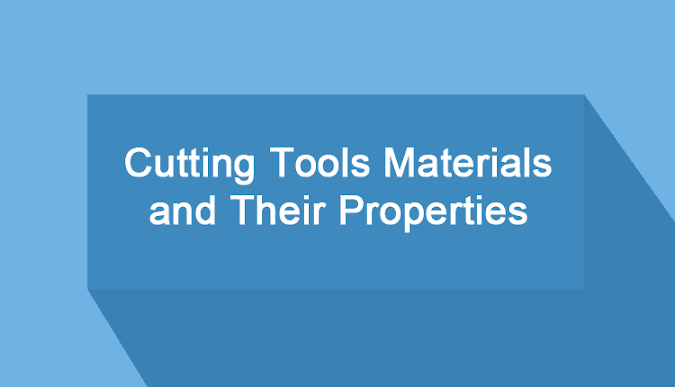Different Types of Cutting Tools Materials and Their Properties

There are many types of cutting process done in different conditions. In such conditions along with the general requirements of the cutting tool, they need some unique properties. To achieve this properties the cutting tools are made up of different material. The material chosen for a particular application depends on the material to be machined, type of machining, quantity and quality of production.
According to the material used the tools are classified into
- Carbon tool steel
- High speed steel tool (HSS)
- Cemented carbide
- Ceramics tool
- Cubic boron nitride Tool (CBN)
- Diamond tool
Carbon tool steel
Carbon steel tool is used in twist drills, milling tools, turning and forming tools, used for soft material such as brass, aluminum magnesium, etc.
Temperature - 450°C
Hardness – up to HRC 65
High-speed steel (HSS)

This is a high carbon steel with a significant amount of alloying element, such as tungsten, molybdenum, chromium, etc. to improve hardenability, toughness and wear resistance. It gives a higher metal removal rate. It loses its hardness at a moderate temperature about 650°C. Therefore, a coolant should be used to increase tool life. It can use many times by re-sharpening. Some surface treatment is done on the HSS to improve its property.
To find out the effect of alloying material in steel click here
Nitriding - Increase wear resistance
Chromium electroplating - Reduce friction
Oxidation - Reduce friction
High-speed steel tools are used in drills, milling cutters, single point lathe tools, broaches.
Cutting speed range - 30-50 m/min
Temperature - 650°C
Hardness – up to HRC 67
T-Type - Tungsten predominant type
M-Type - Molybdenum dominant type
To find out the effect of alloying material in steel click here
Surface treatment used in the HSS
Super finishing - Reduce frictionNitriding - Increase wear resistance
Chromium electroplating - Reduce friction
Oxidation - Reduce friction
High-speed steel tools are used in drills, milling cutters, single point lathe tools, broaches.
Cutting speed range - 30-50 m/min
Temperature - 650°C
Hardness – up to HRC 67
T-Type - Tungsten predominant type
M-Type - Molybdenum dominant type
Cemented carbide tool and cermet
 |
| Carbide drill |
The cemented carbide cutting tool is produced by powder metallurgy technique. It consists of tungsten, tantalum and titanium carbide with cobalt as a binder (when the binder is nickel or molybdenum, then it is called cermet). Cemented carbide tools are extremely hard; they can withstand very high-speed cutting operation. Carbide tool does not lose their hardness up to 1000° C. A high cobalt tool is used for a rough cut while low cobalt tool used for finishing operations.
Cutting speed range - 60-200m/min
Temperature - 1000°C
Hardness – up to HRC 90
🔗Recommended Solution For Different Type Of Carbide Tool Failure And Problems
Cutting speed 300-600m/min
Temperature - 1200°C
Hardness – up to HRC 93
Speed 600-800m/min
Hardness - higher than HRC 95
 It is the hardest material known and it is also expensive. It possesses very high thermal conductivity and melting point. Diamond offers excellent abrasion resistance, low friction coefficient and low thermal expansion. It is used in machining very hard material such as carbides, nitrides, glass, etc. Diamond tools give a good surface finish and dimensional accuracy. They are not recommended for machining steel.
It is the hardest material known and it is also expensive. It possesses very high thermal conductivity and melting point. Diamond offers excellent abrasion resistance, low friction coefficient and low thermal expansion. It is used in machining very hard material such as carbides, nitrides, glass, etc. Diamond tools give a good surface finish and dimensional accuracy. They are not recommended for machining steel.
Cutting speed range - 60-200m/min
Temperature - 1000°C
Hardness – up to HRC 90
🔗Recommended Solution For Different Type Of Carbide Tool Failure And Problems
Ceramics
Most common ceramic materials are aluminum oxide and silicon nitride. Powder of ceramic material Compacted in insert shape, then sintered at high temperature. Ceramic tools are chemically inert and possess resistance to corrosion. They have high compressive strength. They are stable up to temperature 1800°C. They are ten times faster than HSS. The friction between the tool face and chip are very low and possess low heat conductivity, usually no coolant is required. They provide the very excellent surface finish.Cutting speed 300-600m/min
Temperature - 1200°C
Hardness – up to HRC 93
Cubic boron nitride (CBN)
It is the second hardest material after diamond. They are generally used in hand machines. They offer high resistance to abrasion and use as an abrasive in grinding wheels. Sharp edges are not recommended.Speed 600-800m/min
Hardness - higher than HRC 95
Diamond

 |
| Hot hardness of cutting tool material |

